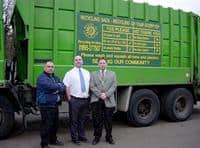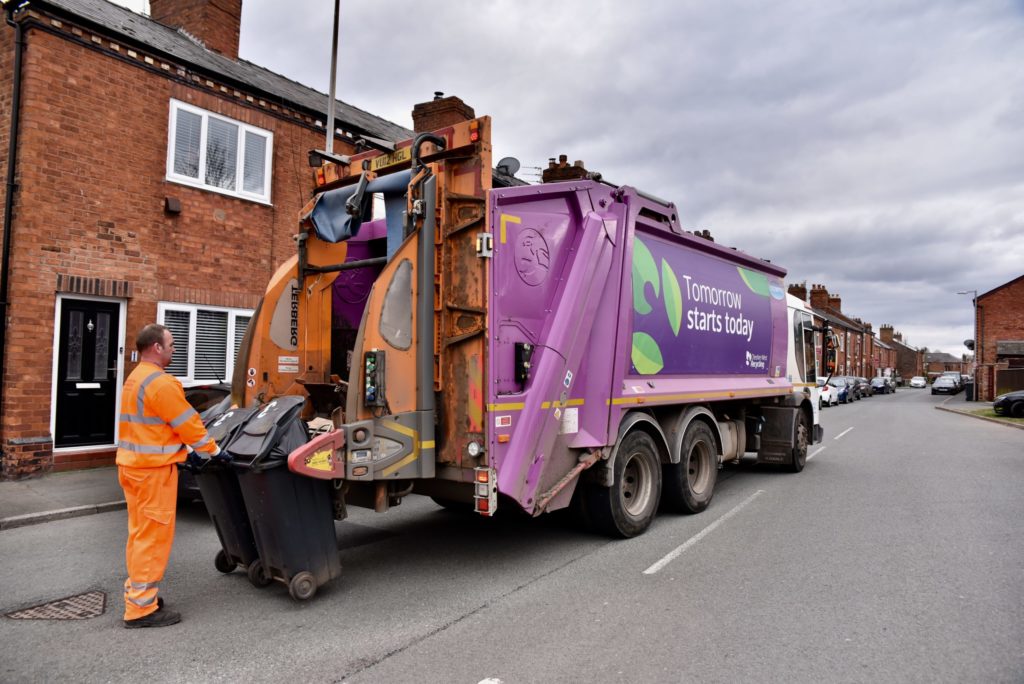The borough hopes that its green waste initiative, which was launched at the beginning of April 2003, will help lift it to the top of the capital's recycling league table after quietly achieving an impressive 19.3 % recycling rate last year – four years ago it was only 7.6%.
The borough, which now includes Heathrow Airport, has a population of about 260,000 with a total of 100,404 households. About half the residents live in detached or semi-detached homes with 27% in terraced housing and the remainder in flats. The major Waste service operations are all provided in-house, not on political grounds but rather that the waste division has successfully delivered a competitive and efficient service for many years. However, in addition Hillingdon does have a total of 18 different private sector partners who also help to deliver the Borough's recycling programme with operations ranging from the receipt of collected materials to the provision and servicing of banks for certain materials collected via the Borough's extensive network of bring sites.
Competitive
The in-house success can be traced back to the days of compulsory competitive tendering in the 1980s when Margaret Thatcher was Prime Minister. The development of Hillingdon's in-house service from then and until now is seen by the team running it as a story of achievements in winning competitive tenders and overcoming real challenges in delivering an efficient and cost effective service as well as meeting targets.
There are three key people involved today at officer level with running the waste collection, recycling and composting services. Colin Russell is the Waste Manager, Olly Shah is the Refuse and Recycling Supervisor and Duncan Jones, who joined Hillingdon in 1994, is in charge of recycling under the title of Waste Development Manager.
He can recall the challenge of CCT. “There has always been strong competitive pressures on us from contractors. We have many firms operating in the borough and nearby including Biffa and Sita. The interest in winning Hillingdon was vast partly because of our location with the M25, M4 and M40 as well as the fact that we are the second largest borough in London.”
During the days of CCT, Mr Russell says that a reason for the success of the borough's in-house team was that it met a rigid client contract. “It was a matter of client and contractor, survival and cost. We won it on business lines and the client contractor was as rigorous with us as with the private sector. Everything was played 100% straight down the line resulting in us winning contracts under Tory and Labour administrations.”
Best Value
The contract was won again in December 1997 with the concept of Best Value brought in to the award. Mr Russell recalls: “CCT operated from a business and purely commercial perspective and did let councils get their house in order. But, there was also too much emphasis on the client checking operation.” Other disadvantages of a rigid CCT approach, he notes, were that it encouraged very low prices which sometimes could not have been sustained by the private sector and didn't bring any realistic margins for the contractor.
Now that CCT is history the situation has changed. While the department remains under commercial pressure the client side of the council now operates in synergy with the delivery arm and the three officers describe this as a form of “cross-fertilisation”.
Mr Russell explains: “There has been a merging of client and contractor. We work together in one team with no client contractor split at all. We only have the waste division which includes refuse collection, Civic Amenity sites and recycling and now kerbside composting collection.”
New approach
The new approach brings financial benefits as well. Says Mr Russell: “As a contractor, if a contract lost money they would be out of a job. So in the past it was all about money, running the contract and making a large surplus. I would not have said that if I had £200,000 going spare, that I could do a kerbside recycling scheme which would make the whole service more effective; it would have meant a separate contract probably with another service provider”.
All three agree that there have been occasions when a crescendo of voices says that meeting high recycling targets through using an in-house team can't be done. Says Mr Jones: “We have had to bang the drum to get people on board in the council and in Hillingdon to show that we can meet targets and do this using the in-house route.”
This close-knit team produces results, says Mr Jones. “The three people you need are here, implementation, monitoring and supervisory and there are advantages having a small number of management officials. The Audit Commission awarded us two stars for our best value performance and said our approach was unique.”
The three accept that it could be seen as a “cosy arrangement”. Says Mr Russell: “Yes it is but it is very challenging among ourselves and is measured on results and cost performance. We are regularly compared to other boroughs and our members still ask about the reasons for an in-house service. In the department we want to know if other boroughs are beating us, we want to know why. We look closely at costs in other boroughs, costs per household for refuse collection and recycling and we are still one of the best performing in terms of costs.”
In the 1990s recycling in Hillingdon was carried out on a limited bring-basis with a range of banks for glass, paper and textiles at supermarket sites and also within CA sites. The council's focus was purely on delivering an efficient refuse collection service.
In 1997 recycling was starting to be talked about as targets for local authorities were discussed more seriously. Mr Jones says: “Really recycling was just an add on then, it was a tick box as to whether we had a plan. But, quite soon after that we started to look at recycling more seriously with a fortnightly kerbside collection scheme using clear sacks getting underway a year later.”
Disposal costs
Mr Russell cites the increasing disposal costs as a factor in the move to recycling. “Landfill costs were in the news and the Landfill Tax had come in 1996 and sparked an interest. The disposal bill went up thousands of pounds overnight and the product of this was a trial of 10,000 households on kerbside in 1998.”
Later in 1999/00 a draft recycling strategy was drawn up taking account of both what the Mayor wanted to do in London as well as the national waste strategy. The strategy recommended an additional investment into the provision of kerbside to the remaining 80,000 households which was approved with the final 20,000 due to receive the service by July 2004.
The dry recyclables go to the Grundon MRF at Colnbrook, about five miles away. This is one of the few cases of Hillingdon using a contractor and Mr Jones say that the approach is to leave Grundon to handle the markets for material. “Local authorities should not get too bogged down with the market and the advantage we see in Grundon is that the gate fee is the easier thing to budget for. Although we have been criticised in the past when newspapers have gone up in value, there is an advantage to having a steady contract. There is a role for the private sector and there is also a role for the public sector.”
The recycling team accept that not everyone puts out dry recyclables. But, they acknowledge that if everyone used the service in one go, this might cause a problem although there is every hope that more and more householders will take up the scheme. Mr Jones remarks: “If every one tomorrow had boroughwide recycling, I do think markets would be swamped.”
Collections include plastic bottles and Mr Russell reasons that while recycling is about weight for most councils, “it is not just a statistics game. Plastic is an important thing to pull out and I think it would be very narrow-minded from a borough view not to collect it. We don't just think of what helps us up the league table.”
The waste division has also helped other Hillingdon council departments become more sustainable to the benefit of the division. “We went to the marketplace and took over waste disposal function of our highways department saving about £300,000 per annum most of which is going to help fund the green waste scheme,” says Mr Russell.
Green waste
The green waste scheme is currently the pride of the department. Launched at the beginning of April across the borough, households have been given three strong plastic fibre sacks which are emptied fortnightly into standard dustcarts operating as green waste collection vehicles. The sacks were seen in use in Colchester and Hillingdon, on talking to the Colchester workers, opted to put a handle on the bottom of the bags to make emptying easier. The council considers that using sacks avoids the problem for residents of where to store a green bin.
Ahead of the green waste scheme, leaflets and bags were delivered. Mr Jones recalls: “At the time we were the most nervous about any project we had undertaken. Recycling is easier to judge. How do you judge how much green waste there will be from a new scheme?”
Collection is on a fortnightly rota, on the same day as kerbside and refuse. This does mean three vehicles going to each house but using normal RCVs, have to look at payloads and we are adapting them to catch some of the liquids. The green waste vehicles stand out in bright red and have been logoed up for their work. Five have been leased on a long term basis for the summer period April to October from Fiveways, with a reduced number operating over the winter using a mix of regular and casual staff. Funding for the green waste project came largely from the DEFRA £140 million waste fund through the £21 million allocated to London. Following a successful application Hillingdon received a grant of 428,000 including £228,000 capital funding for the bags, with the balance used a revenue support funding to finance the collection vehicles are crew.
The green waste currently goes to EQ Waste in Hertfordshire through a West London Waste Authority contract. And, Hillingdon itself is looking at the possibility of using a local composting facility which has plans for an in-vessel system.
Already, the borough is achieving good tonnages from the kerbside. Figures for April show that 581 tonnes of green waste was collected and the figure jumped to 724 tonnes in May. Adding in kerbside recyclable figures, this gives a recycling rate per household of 31.94 tonnes in May.
Altogether, Hillingdon's recycling programme is looking to divert in the region of 34,000 tonnes from landfill including 20,000 tonnes from the Borough's kerbside recycling programme (mixed dry recyclables and compostable garden wastes) with the remaining 14,000 tonnes coming from the Borough's extensive network of bring facilities plus recycling at each of the Borough's three civic amenity sites.
With the green waste about 8,000 tonnes was collected via civic amenity sites last year.
Now while focussing on building up its current rates of return from its recycling infrastructure, the department is looking to the future and how it can drive its recycling rates higher. This is likely to include continuing promotion of the kerbside service and ways to extend glass and textile recycling.











Subscribe for free